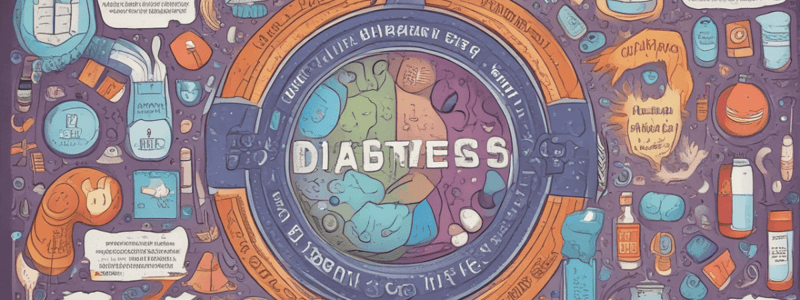Podcast
Questions and Answers
What is the total energy value in kcal of the average man's fuel reserves?
What is the total energy value in kcal of the average man's fuel reserves?
- 150000
- 200000
- 167850 (correct)
- 180000
How long after a meal do blood glucose concentrations return to normal?
How long after a meal do blood glucose concentrations return to normal?
- 4 hours
- 2 hours (correct)
- 3 hours
- 1 hour
What is the primary source of energy in the fasting state?
What is the primary source of energy in the fasting state?
- Muscle protein
- Adipose tissue TAG (correct)
- Body fluids glucose
- Liver glycogen
What is the enzyme activated by glucagon and adrenaline in adipose tissue?
What is the enzyme activated by glucagon and adrenaline in adipose tissue?
What is the first supplier of blood glucose in the fasting state?
What is the first supplier of blood glucose in the fasting state?
What is the reaction catalyzed by Pyruvate dehydrogenase?
What is the reaction catalyzed by Pyruvate dehydrogenase?
What is the effect of insulin on Pyruvate dehydrogenase?
What is the effect of insulin on Pyruvate dehydrogenase?
What is the destination of excess acetyl CoA in the fed state, liver?
What is the destination of excess acetyl CoA in the fed state, liver?
What is the primary reason why the metabolic pattern in uncontrolled diabetes mellitus resembles that of starvation, but with more exaggerated effects?
What is the primary reason why the metabolic pattern in uncontrolled diabetes mellitus resembles that of starvation, but with more exaggerated effects?
What is a characteristic feature of diabetes type 2?
What is a characteristic feature of diabetes type 2?
What is the primary mechanism that limits muscle protein breakdown, release of fatty acids from adipocytes, and uncontrolled production of ketone bodies in starvation?
What is the primary mechanism that limits muscle protein breakdown, release of fatty acids from adipocytes, and uncontrolled production of ketone bodies in starvation?
What is a common complication of diabetes mellitus?
What is a common complication of diabetes mellitus?
What is the treatment for type 1 diabetes?
What is the treatment for type 1 diabetes?
What is a consequence of uncontrolled diabetes mellitus?
What is a consequence of uncontrolled diabetes mellitus?
What is the primary reason for the inhibition of gluconeogenic substrates into acetyl CoA in liver adipose tissue and muscle?
What is the primary reason for the inhibition of gluconeogenic substrates into acetyl CoA in liver adipose tissue and muscle?
What happens to urea production in prolonged starvation?
What happens to urea production in prolonged starvation?
What is the main function of ketone bodies in prolonged fasting?
What is the main function of ketone bodies in prolonged fasting?
What is the approximate duration of survival in starvation for a young and fit individual?
What is the approximate duration of survival in starvation for a young and fit individual?
What is the main characteristic of Type 1 diabetes mellitus?
What is the main characteristic of Type 1 diabetes mellitus?
What is the primary cause of death in diabetic individuals?
What is the primary cause of death in diabetic individuals?
What is the approximate percentage of diabetics that are Type 1?
What is the approximate percentage of diabetics that are Type 1?
What is the main feature of glucose tolerance curves in diabetic subjects?
What is the main feature of glucose tolerance curves in diabetic subjects?
Flashcards are hidden until you start studying
Study Notes
Diabetes Mellitus
- Diabetes type 2: usually later onset, insulin resistance, milder than type 1, associated with diet and lifestyle (e.g. obesity), increasing incidence (including in children)
- Hyperglycemia but usually no ketoacidosis, often responds to diet and oral hypoglycaemic agents
Metabolic Pattern in Uncontrolled Diabetes Mellitus
- Resembles starvation, but effects are more exaggerated
- In starvation, insulin is low, glucagon acts unopposed
- KB produced in starvation stimulate insulin release, limiting muscle protein breakdown, FA release from adipocytes, and uncontrolled KB production
- This mechanism does not operate in diabetes
Metabolism in Diabetes
- High glucagon, low insulin
- Glucose and KB production
Chronic Complications of Diabetes Mellitus
- Microangiopathy: changes in small blood vessel walls, thickening of basement membrane
- Retinopathy: blindness 25 times more common in diabetic patients
- Nephropathy: renal failure 17 times more common
- Neuropathy: postural hypotension, impotence, foot ulcers
Treatment
- Type 1: exogenous insulin by injection
Fuel Reserves in the Average Man
- Total fuel reserves: 167,850 Kcal (697.8 MJ)
- Glycogen: 300g (muscle), 80g (liver), energy value: 1460 Kcal (6.1 MJ), 330 Kcal (1.4 MJ)
- Glucose: 15g (body fluids), energy value: 60 Kcal (0.3 MJ)
- TAG: 15kg (adipose tissue), energy value: 140,000 Kcal (580 MJ)
- Protein: 6kg (muscle), energy value: 26,000 Kcal (110 MJ)
The Fasting (Post-Absorptive) State
- Blood glucose concentrations peak an hour after eating, return to normal by 2 hours
- Blood glucose is removed for oxidation or storage
- Concentration of insulin drops, glucagon rises
Metabolism in the Fasting State
- Early events: liver and adipose tissue
- Liver maintains blood glucose concentrations at about 4mM
- Adipose tissue provides greatest source of energy as TAGs
- Hormone-sensitive lipase activated by glucagon and adrenaline
- FA transported to liver bound to albumin
Glucose Production by the Liver
- Liver glycogen is the first supplier of blood glucose
- Gluconeogenesis follows from lactate, glycerol, and amino acids
- After 24 hours of fasting, all blood glucose comes from gluconeogenesis
Sources of Blood Glucose After Ingestion of 100g Glucose
- Not shown in the original text, but mentioned as a topic
Fatty Acids are NOT Gluconeogenic Precursors
- Reaction catalysed by Pyruvate dehydrogenase is IRREVERSIBLE
- PDH is activated by insulin and inhibited by glucagon
- Ensures that in fasting, gluconeogenic substrates are channelled into glucose production, not acetyl CoA formation
Fed State, Liver:
- Glycolytic enzymes are activated, pyruvate dehydrogenase is activated, and excess acetyl CoA is channelled into FA synthesis
Fasting State, Liver:
- FA can be used as fuel by liver, adipose tissue, and muscle; draining of gluconeogenic substrates into acetyl CoA is inhibited, and conversion to glucose is favoured
Ketone Body Formation
- FA oxidation in hepatocyte leads to high concentrations of Acetyl CoA
- It exceeds the capacity of the TCA cycle
- It is channelled into ketone body formation
- Acetoacetate and β-hydroxybutyrate are released into the bloodstream
- Most tissues oxidize a mixture of FA and KB
- Erythrocyte uses glucose
- Brain uses glucose and small amount of KB
Prolonged Fasting (Starvation)
- If the early pattern continued, body protein would be severely depleted
- Only about a third of body protein can be lost without severe or fatal consequences
Fuel Concentration in the Blood in Prolonged Fasting
- Not shown in the original text, but mentioned as a topic
Metabolism in Starvation
- As starvation continues, more KB are recovered from the kidney
- Muscle uses FA rather than KB
- FA concentrations plateau, KB rise
- Brain can use more KB and less glucose
- Need for gluconeogenesis is reduced, muscle protein breakdown decreases
- Urea production decreases
Ketone Bodies
- Act on pancreas to stimulate insulin release
- Limit muscle proteolysis and adipose tissue lipolysis
- Muscle tissue is conserved
Eventually
- Amount of adipose tissue is an important determinant of survival
- Death comes from fuel exhaustion, loss of function from loss of protein, and impairment of the immune system
- Death from starvation is often due to infection
- About 40 days (young and fit, may be longer)
Glucose Tolerance Curves of Normal and Diabetic Subjects
- Not shown in the original text, but mentioned as a topic
Diabetes Mellitus
- Affects 6% of population in UK
- 90% of all endocrine disorders
- Major cause of blindness, amputations, premature deaths
- 10% of total health care budget
Studying That Suits You
Use AI to generate personalized quizzes and flashcards to suit your learning preferences.




